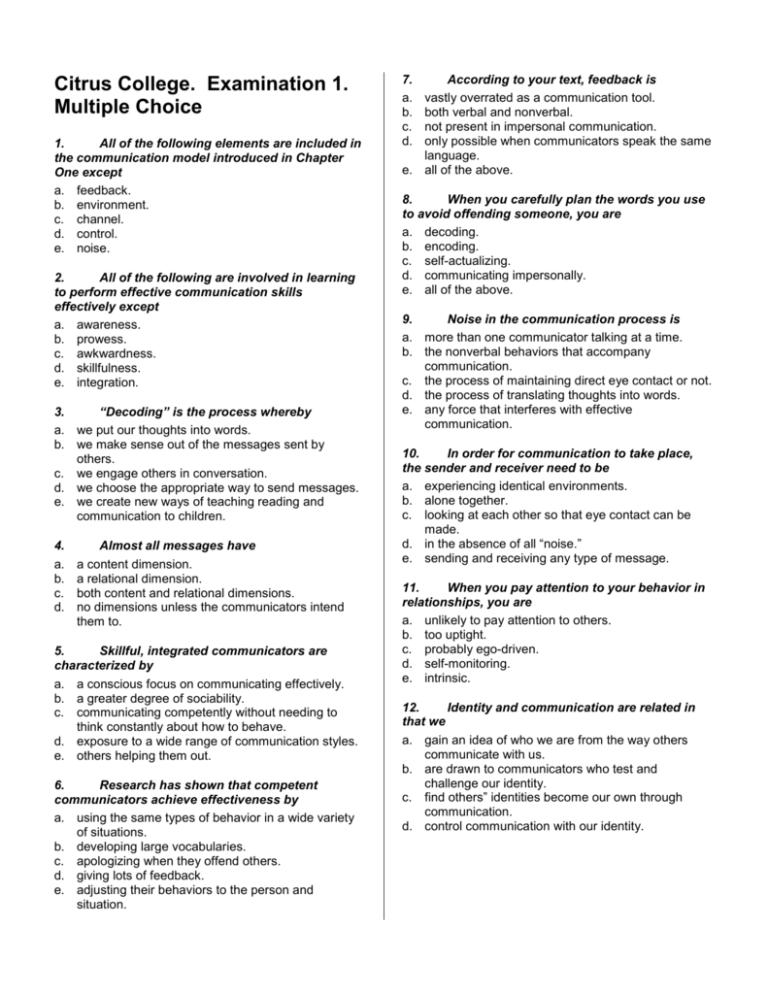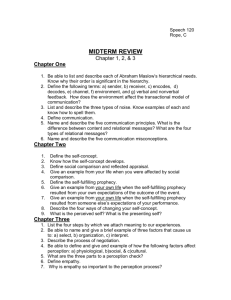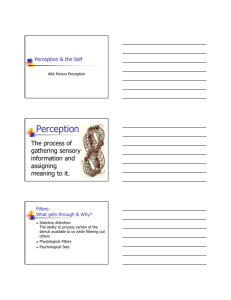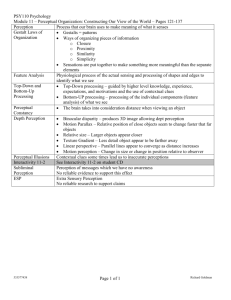Citrus College. Examination 1. Multiple Choice
advertisement

Citrus College. Examination 1. Multiple Choice 1. All of the following elements are included in the communication model introduced in Chapter One except a. feedback. b. environment. c. channel. d. control. e. noise. 2. All of the following are involved in learning to perform effective communication skills effectively except a. awareness. b. prowess. c. awkwardness. d. skillfulness. e. integration. 3. “Decoding” is the process whereby a. we put our thoughts into words. b. we make sense out of the messages sent by others. c. we engage others in conversation. d. we choose the appropriate way to send messages. e. we create new ways of teaching reading and communication to children. 4. a. b. c. d. Almost all messages have a content dimension. a relational dimension. both content and relational dimensions. no dimensions unless the communicators intend them to. 5. Skillful, integrated communicators are characterized by a. a conscious focus on communicating effectively. b. a greater degree of sociability. c. communicating competently without needing to think constantly about how to behave. d. exposure to a wide range of communication styles. e. others helping them out. 6. Research has shown that competent communicators achieve effectiveness by a. using the same types of behavior in a wide variety of situations. b. developing large vocabularies. c. apologizing when they offend others. d. giving lots of feedback. e. adjusting their behaviors to the person and situation. 7. a. b. c. d. According to your text, feedback is vastly overrated as a communication tool. both verbal and nonverbal. not present in impersonal communication. only possible when communicators speak the same language. e. all of the above. 8. When you carefully plan the words you use to avoid offending someone, you are a. decoding. b. encoding. c. self-actualizing. d. communicating impersonally. e. all of the above. 9. Noise in the communication process is a. more than one communicator talking at a time. b. the nonverbal behaviors that accompany communication. c. the process of maintaining direct eye contact or not. d. the process of translating thoughts into words. e. any force that interferes with effective communication. 10. In order for communication to take place, the sender and receiver need to be a. experiencing identical environments. b. alone together. c. looking at each other so that eye contact can be made. d. in the absence of all “noise.” e. sending and receiving any type of message. 11. When you pay attention to your behavior in relationships, you are a. unlikely to pay attention to others. b. too uptight. c. probably ego-driven. d. self-monitoring. e. intrinsic. 12. Identity and communication are related in that we a. gain an idea of who we are from the way others communicate with us. b. are drawn to communicators who test and challenge our identity. c. find others” identities become our own through communication. d. control communication with our identity. 13. Which is an example of “noise” as the term is defined in your text? a. a jet flying low overhead while you’re trying to talk b. a headache that interferes with your listening c. feelings of anger directed toward a partner d. preoccupation with another topic during a lecture e. all of the above 14. Feedback is a. the discernable response of a receiver to a sender’s message. b. encoding your message. c. writing an invitation to a party. d. telling your boss you need time off. 15. Which of the following is a channel for communication? a. escape b. control c. inclusion d. esteem e. touch 16. The ability to construct a variety of different frameworks for viewing an issue is termed a. feedback framework. b. cognitive complexity. c. communication competence. d. metacommunicating. e. integration. 17. If you want to feel more self-confident when meeting new people, your text advised you to a. subscribe to the myth of perfection. b. compare yourself to reference groups above you. c. quit thinking you can change. d. disregard obsolete or inaccurate feedback. 18. All of the following are examples of social comparison except a. being graded for a test on a class curve. b. judging your attractiveness while working out at Nautilus gym. c. reflecting on how you’ve changed in the last year. d. being offered a job after competitive interviews. e. all of the above are examples of social comparison. 19. a. b. c. d. e. A self-fulfilling prophecy is a way to discover how to act in the future. a test one can take to analyze one’s self-concept. a way to discover the “real you.” an expectation that affects behavior. a psychological form of extrasensory perception. 20. The tendency to seek and attend to information that conforms to an existing selfconcept has been labeled a. reflected appraisal. b. significance posturing. c. the stability hypothesis. d. cognitive conservatism. e. the weak spine phenomenon. 21. The tendency to look for people who confirm our existing self-concept is termed a. behavioral conservatism. b. self-verification. c. cognitive monitoring. d. self-fulfillment. e. relational prophecy. 22. The communication strategies people use to influence how others view them is the process of a. ego-video. b. reflected appraisal. c. manipulation. d. social ethics. e. identity management. 23. The self-concept a. causes all of our communication behavior. b. prevents low self-esteem. c. is partially shaped by significant others from our past. d. is the way significant others will view us in the future. 24. If you want to change your self-concept, you should a. have realistic expectations and perceptions. b. ask others to send you only positive messages. c. take yourself less seriously. d. It is not possible to change the self-concept. 25. a. b. c. d. e. People who have low self-esteem are likely to approve of others. perform well when being watched. work harder for critical people. expect to be rejected by others. had traumatic childhoods. 26. Which of the following is definitely not an example of a self-fulfilling prophecy? a. A child fails a test after hearing her teacher tell her mother that she is an underachiever. b. A student who previously complained of stage fright loses his place during a class speech and can’t go on. c. A husband reluctantly agrees, with reservations, to his wife’s request that they spend the holiday visiting Disneyland. He has a terrible time. d. Both b and c above qualify as examples of selffulfilling prophecies. e. All of the above qualify as examples of self-fulfilling prophecies. 32. The relatively stable set of perceptions you hold of yourself is called your a. self-concept. b. interpersonal self. c. perceptual bias. d. self-feedback. e. self-orientation. 27. All of the following are methods you could use to make your self-concept more realistic except a. Share your perception of yourself with a friend. b. Try to engage in more accurate self-talk. c. Make an effort to recognize more “ego buster” messages. d. Pay less attention to your past and more attention to your present behavior. 33. A self-fulfilling prophecy is a. an accurate prediction about another’s behavior, based on background knowledge. b. a prediction about one’s own behavior, based on past experience. c. a prediction which affects the outcome of one’s own or another’s behavior. d. a mistaken prediction which fails to occur. e. none of the above. 28. All of the following are true of the selfconcept except that a. it is objective. b. it is changing. c. it is, in part, a product of interaction with others. d. it is, in part, a product of our early childhood experience. e. it can be changed. 29. The term “self-concept” refers to a. the sum of one’s physiological, social, and psychological attributes as perceived by an impartial observer. b. the way an individual believes others perceive her/him. c. the total of an individual’s beliefs about his/her physical characteristics, intelligence, aptitudes, and social skills. d. the sum of one’s psychological, social, and physical attributes as perceived by a significant other. e. none of the above. 30. a. b. c. d. e. A “significant other” is best defined as a powerful adult. a person who has affected one’s self-concept. a totally supportive person. an extremely negative influence. all of the above. 31. People who are high self-monitors a. are much more aware of their impression management behavior than others. b. express what they are feeling without paying much attention to the impression their behavior creates. c. are usually bad actors. d. are not usually good “people readers.” e. are easier to “read” than low self-monitors. 34. People who have high self-esteem a. expect to be accepted by others. b. have less of a need to work hard for people who demand high standards. c. are unable to defend themselves against negative comments. d. don’t perform well when being watched. 35. The process of judging ourselves by how we think others evaluate or judge us is called a. the “sell-out” self. b. self-matching. c. reflected appraisal. d. totality viewing. e. the feedback self. 36. “Reference groups” are a. people whose self-concepts we have influenced. b. individuals whose self-esteem has been diminished. c. groups against which a person compares him/herself. d. groups formed to improve shaky self-esteem. e. people who hang around the library. 37. All of the following are perceptual errors described in the book except a. We are influenced by what is most obvious. b. We tend to assume others are different from us. c. We tend to favor negative impressions over positive ones. d. We often judge ourselves more charitably than others. e. All of the above were perceptual errors described in the book. 38. A perception check includes a. a description of the behavior you have noticed. b. two possible interpretations of the behavior. c. a request for clarification about how to interpret the behavior correctly. d. all of the above. e. none of the above. 39. are a. b. c. d. e. The three stages in the perception process initial, intermediate, final. assumption, experience, expectation. physical, psychological, experimental. selection, organization, interpretation. response, action, interaction. 40. Using the skill of perception checking will help prevent a. negative self-fulfilling prophecies. b. physiological noise. c. inaccurate decoding of messages. d. excessive feedback. e. none of the above. 41. Exaggerated beliefs associated with a perceptual categorizing system are a. role constructs. b. self-judgments. c. white lies. d. subcultural translations. e. stereotypes. 42. Empathy is related to perception in that a. the more perceptive you are, the less empathetic you need be. b. the more perceptive you are, the easier it is to forget to be empathetic. c. empathy is facilitated by trying to perceive things from the other person’s point of view. d. empathy and perception are both a result of selffulfilling prophecies. 43. All of the following are causes of inaccurate perception except a. We cling to first impressions. b. We’re influenced by what is most obvious. c. We assume others are similar to us. d. We rate ourselves more negatively than others see us. e. We judge ourselves more charitably than others. 44. Classifying people according to age, sex, and physical attractiveness, rather than education or occupation, illustrates the cognitive framework called a. figure-ground organization. b. c. d. e. perceptual schema. perceptual freezing. selection. selective attention. 45. Perception checking focuses on what part of the perception process? a. selection b. organization c. interpretation d. all of the above e. none of the above 46. What’s missing from this perception check? “When I saw you having lunch with Emily, I figured you liked her more than me. What’s going on?” a. It doesn’t describe behavior. b. It has only one interpretation. c. It doesn’t request clarification. d. It is too wordy. e. Nothing is missing from this perception check. 47. What’s missing from this perception check? “When you bought that pink shirt, I figured you did it just to please me or really liked how you looked in it. Why did you buy it?” a. It doesn’t describe behavior. b. It has only one interpretation. c. It doesn’t request clarification. d. It is too wordy. e. Nothing is missing from this perception check. 48. Communicating to a friend how sorry you are about the breakup of his or her romance is an example of a. sympathy. b. role-taking. c. perception-checking. d. assumption. 49. All of the following are physiological factors shaping perception except a. the senses. b. age and health. c. fatigue. d. ethnicity. e. hunger. 50. Our own perceptions can sometimes be distorted due to a. defending our own positions. b. situational constraints. c. acknowledging the fact that people are different. d. the needs and biases of others.









